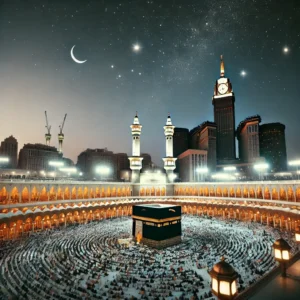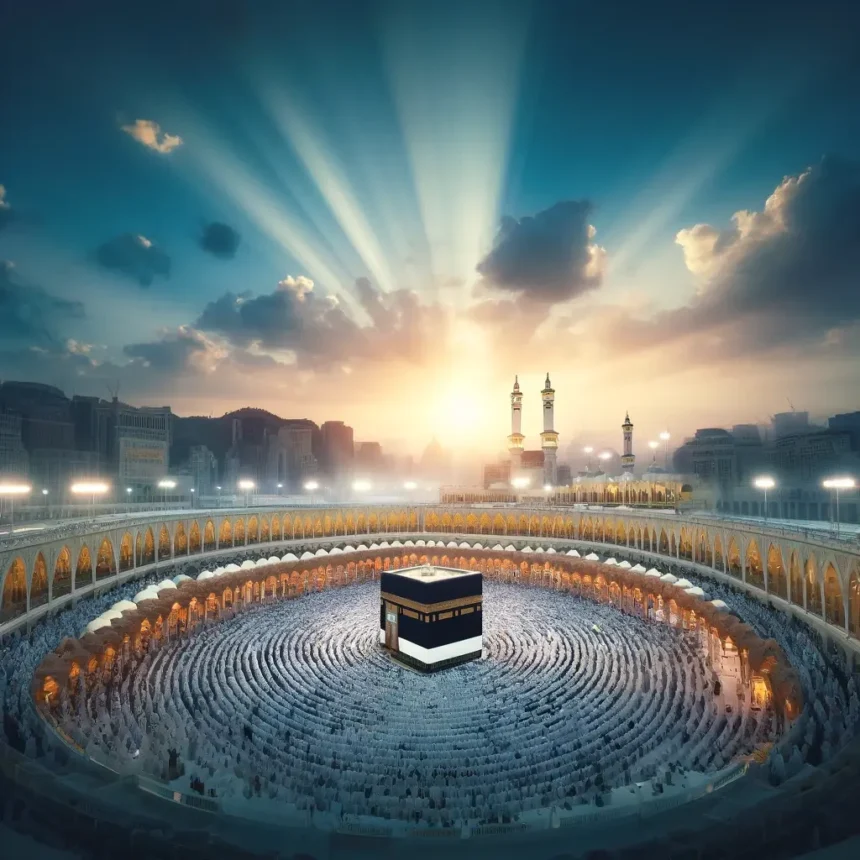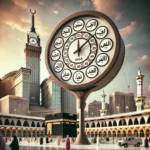Introduction
Prayer (Salah) is an essential pillar of Islam, observed by millions of Muslims around the world. Mecca, the holiest city in Islam, holds a unique position for Muslims as they turn towards it for their daily prayers. The concept of prayer times in Mecca, known as “اوقات الصلاة مكة,” is deeply connected with the five daily prayers. These prayers are carefully timed according to the position of the sun and the guidelines set by Islamic tradition.
What are “اوقات الصلاة مكة”?
Muslims in Mecca follow specific times for performing their daily prayers, known as ‘اوقات الصلاة مكة.’ These prayer times change daily, depending on the sun’s position. Each day, Muslims pray five times: Fajr, Dhuhr, Asr, Maghrib, and Isha.
Fajr: The Dawn Prayer
The Fajr prayer is the first prayer of the day, and its time starts just before sunrise. It is a short prayer, performed in two units (rakats). The significance of Fajr lies in its early timing, marking the beginning of the day and a fresh start. The precise time for Fajr in Mecca can vary depending on the season, as it is aligned with dawn.
Dhuhr: The Midday Prayer
Dhuhr prayer is performed when the sun is at its highest point in the sky, right after midday. This is the longest prayer and consists of four rakats. “اوقات الصلاة مكة” adjusts the Dhuhr time according to the solar noon, which can change slightly throughout the year.
Asr: The Afternoon Prayer
Asr prayer is performed in the late afternoon before the sun begins to set. Like Dhuhr, it also consists of four rakats. The shadow of an object being twice its length determines the prayer time, indicating the afternoon’s progression. Asr marks the winding down of the day as evening approaches.
Maghrib: The Sunset Prayer
Maghrib is performed immediately after the sun sets. This prayer is shorter, consisting of three rakats, and signifies the close of the day. “اوقات الصلاة مكة” places high importance on Maghrib as it transitions the faithful from day into night.
Isha: The Night Prayer
Isha is the final prayer of the day, performed when the sky is completely dark. It consists of four rakats and allows Muslims to reflect on the day’s events before resting. The timing of Isha in Mecca follows the complete disappearance of twilight.
Importance of “اوقات الصلاة مكة”
Muslims greatly dedicate themselves to following “اوقات الصلاة مكة” because they believe timely prayers bring greater rewards. Mecca holds special significance for Muslims worldwide because it is home to the Kaaba, the focal point for all prayers. Observing prayers at the exact times strengthens one’s spiritual connection with Allah and provides a disciplined structure to a Muslim’s daily life.
Spiritual Discipline
The regularity of prayer times in Mecca instills a sense of discipline in a Muslim’s life. Aligning daily activities around prayer times ensures that Muslims remain connected to their faith, no matter what their day brings. Each prayer marks a pause from the routine, offering a moment for reflection, gratitude, and humility.
Alignment with Nature
“اوقات الصلاة مكة” are tied directly to the natural cycles of the sun, creating a deep connection between spirituality and the universe. Muslims in Mecca and around the world feel this bond with nature as they observe each prayer at its prescribed time, understanding the celestial significance of each movement of the sun.
Community Bonding
Praying at the mosque in Mecca, particularly at the Grand Mosque (Masjid al-Haram), during the set times creates a unique sense of community. Muslims gather together for prayers, creating bonds with fellow believers while simultaneously worshiping Allah. The sight of thousands of people praying in unison at the Grand Mosque is a powerful display of faith and unity.
How “اوقات الصلاة مكة” are Determined
The determination of “اوقات الصلاة مكة” is based on the sun’s position, a system that dates back to the time of the Prophet Muhammad (PBUH). Today, modern technology has simplified the process of calculating prayer times in Mecca. Islamic scholars use astronomical data to ensure that Muslims can observe the correct times for each prayer.
Astronomical Calculations
The Islamic calendar is lunar, but prayer times are determined using the solar calendar. Muslim astronomers and scholars calculate the angles of the sun’s position relative to the horizon to establish the exact moments for each prayer. These calculations are precise and vary depending on the geographical location of Mecca.
Local Observation
In addition to astronomical calculations, local observation still plays a role in determining “اوقات الصلاة مكة.” Traditionally, Muslims would observe the sun’s position directly to estimate prayer times, particularly for Fajr and Maghrib. This method ensures that the prayer times reflect the natural environment.
Prayer Timetables
To help the faithful keep track of prayer times, many mosques and organizations in Mecca publish daily or weekly timetables. Many organizations distribute these timetables widely, helping Muslims observe ‘اوقات الصلاة مكة’ accurately. Additionally, digital tools and mobile apps have made accessing prayer times even more convenient.
Factors Influencing “اوقات الصلاة مكة”
Several factors influence the exact timing of “اوقات الصلاة مكة,” including the time of year, geographical location, and changes in daylight hours.
Seasonal Changes
The time of year greatly affects the duration of daylight and, subsequently, prayer times. For instance, during the summer months, longer days cause Fajr prayer to begin earlier, while Isha prayer takes place later. In contrast, during the winter months, days are shorter, leading to adjustments in prayer times accordingly.
Latitude and Longitude
While “اوقات الصلاة مكة” is specifically for Mecca, Muslims in different parts of the world calculate their local prayer times based on Mecca’s timings, but they make adjustments according to their own geographic location. Distance from the equator and the tilt of the earth affect how much daylight a location receives, influencing local prayer schedules.
Daylight Saving Time
While Mecca itself does not observe Daylight Saving Time, some countries that follow Mecca’s prayer times may adjust their clocks forward or backward. This can temporarily shift the local time for prayers.
Tools to Check “اوقات الصلاة مكة”
Modern technology offers various tools to keep track of “اوقات الصلاة مكة,” ensuring that Muslims can easily determine when to perform their prayers.
Mobile Apps
Several mobile apps specifically help Muslims stay updated with “اوقات الصلاة مكة.” These apps use location-based services to notify users of prayer times based on their current position, and they also allow users to select Mecca for accurate timings.
Websites
Numerous websites provide reliable and updated prayer schedules for Mecca. These websites use real-time astronomical data to offer precise timings and adjustments for prayers.
Mosques and Digital Displays
Many mosques, especially in Mecca, have digital displays showing the current prayer times. This makes it easier for worshipers to ensure they perform their prayers at the correct time.
Benefits of Following “اوقات الصلاة مكة”
Adhering to “اوقات الصلاة مكة” brings both spiritual and personal benefits, promoting a life of mindfulness, discipline, and connection to faith.
Spiritual Growth
Regular observance of prayer times helps Muslims grow spiritually. By praying at the designated times, individuals cultivate a deep sense of gratitude and trust in Allah.
Daily Structure
“اوقات الصلاة مكة” offer a structured routine that provides a sense of balance. Muslims plan their day around the prayers, which allows them to incorporate moments of mindfulness and calm amidst their daily responsibilities.
Health Benefits
In addition to the spiritual rewards, prayer itself has numerous physical benefits. The movements involved in Salah (prayer) stretch and flex different parts of the body, promoting physical well-being.
Sense of Unity
For Muslims in Mecca, following “اوقات الصلاة مكة” brings a strong sense of unity. Praying in congregation, particularly in the Grand Mosque, fosters a deep connection with fellow Muslims and reinforces the communal aspect of worship.

FAQs
What are the five daily prayers in Mecca?
The five daily prayers in Mecca are Fajr, Dhuhr, Asr, Maghrib, and Isha.
How is “اوقات الصلاة مكة” determined?
Muslims determine ‘اوقات الصلاة مكة’ based on the sun’s position, using both traditional observation and modern astronomical calculations.
Does Mecca observe Daylight Saving Time for prayer timings?
No, Mecca does not observe Daylight Saving Time, though other regions may adjust their clocks accordingly.
Can I use mobile apps to check “اوقات الصلاة مكة”?
Yes, many mobile apps offer accurate prayer times for Mecca and other locations around the world.
Why is Fajr prayer so early in Mecca?
Muslims perform the Fajr prayer just before sunrise, marking the start of the day in Islamic tradition.
Conclusion
“sاوقات الصلاة مكة” is more than just a timetable; it is a spiritual guide that helps Muslims organize their day around their devotion to Allah. Whether using traditional methods or modern technology, Muslims in Mecca and around the world observe these prayer times to strengthen their faith and foster a sense of unity with the global Muslim community.





